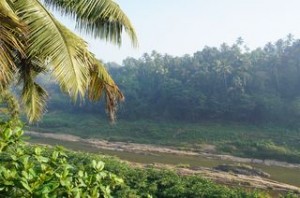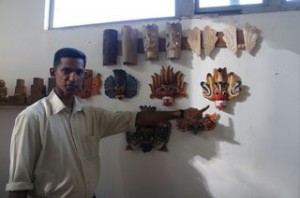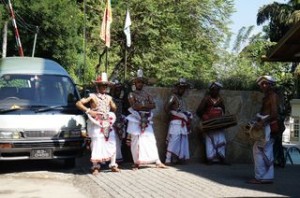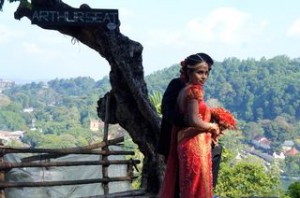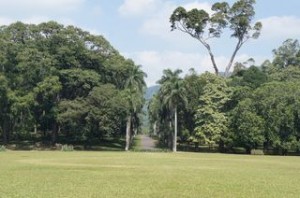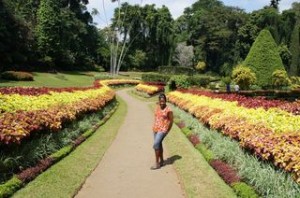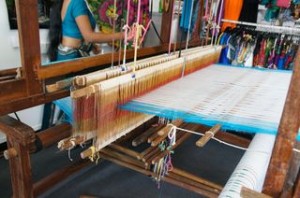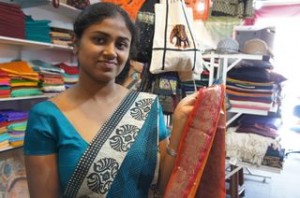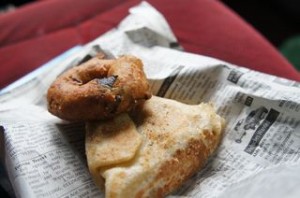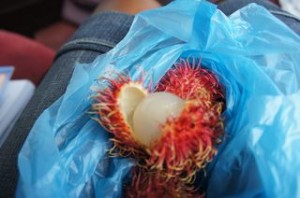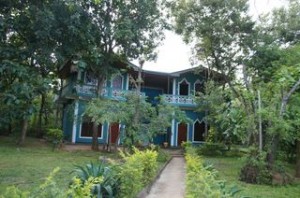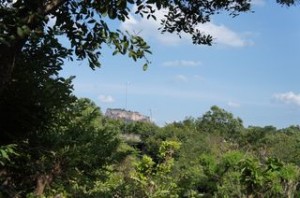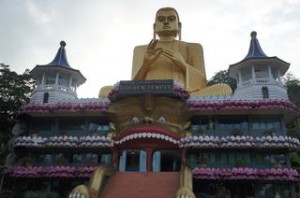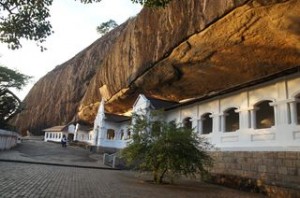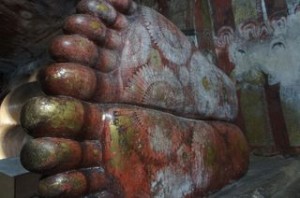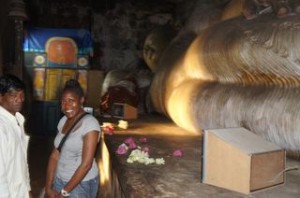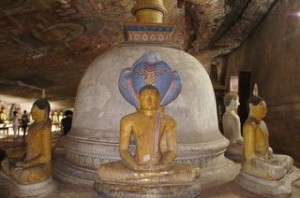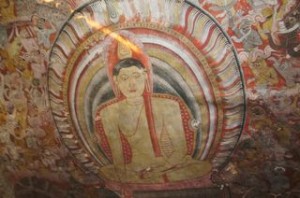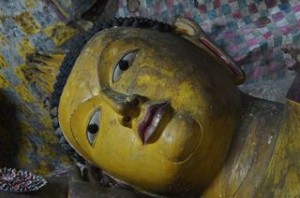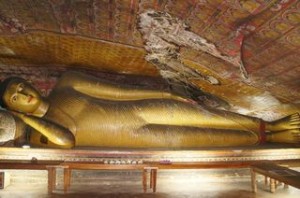When you are traveling with guys, shopping doesn’t often come to mind and they aren’t quick with shopping suggestions. I knew that I wanted to get some tea while in Sri Lanka, but I wasn’t sure what else to bring back home. I got a few recommendations from new friends in Beruwela. Helga from Germany recommended silk in Kandy and I thought getting a couple of Sri Lankan masks would be cool, too. It turns out that Kandy is the perfect place to do a little shopping. After a parting look at our stretch of the longest river in Sri Lanka, the lazy Mahaweli River just behind our guest house, along with a good family-style breakfast, we head for the city. Our first stop is the Rajanima Craft Workshop and Gallery, which turns out to be a treasure trove of Sri Lankan woodcarvings, masks and furniture. We are greeted by Dhamitha who immediately begins explaining the woodcarving and crafting process, starting with the 10 varieties of wood found in Sri Lanka from ebony and teak to coconut and mahogany. In the small workshop, men are sketching designs for carvings, measuring, cutting and smoothing their creations. It’s Dhamitha that explains the meaning of the Sri Lankan masks that I’ve been seeking. Each is like a talisman of sorts meant to ward off bad spirits or welcome good ones. I immediately decide upon a red and yellow mask representing friendship and power along with a peacock mask representing good luck. Masks like these were actually used by native Sinhalas in exorcisms or demon dances to rid people of sickness and disease in ancient days. We descend further into the workshop, which is kind of carved itself, but into the Kandy hillside, and we find ourselves surrounded by all manner of wooden elephants, masks, bowls and any other kind of crafty thing you can imagine. I end up adding a coconut bowl and a coffee table to my mask purchases. Rajanima is a full service craft shop that can ship anywhere in the world and in a couple of weeks time I should have a Sri Lankan crafted coffee table in my living room. I had to avert my eyes from even more pretty things in a back room of the shop, crammed full of carvings before leaving.
We continue up the narrow windy road alongside Kandy Lake passing a group of Kandyan Ves dancers and drummers outside a hotel. Sid tells me that they are probably part of a wedding celebration and waiting for the bride and groom. We stop at Arthur’s Seat, an overlook with stunning views of Kandy below. A pair of newlyweds have chosen the picturesque spot to take photos and tourists, including me have gotten in on the act. They welcomed the attention and seemed to be enjoying their special day. The view of Kandy really is stunning. The lake is a perfect blue-green and the yellow and red tile roofed buildings nestled among green trees tell a beautiful color story. You can’t miss yet another Buddha looking down on it all from his post at the Bahirawakanda Temple, a short distance away. As we make our way down the hill, we see more elaborately dressed Sri Lankans taking part in wedding celebrations. It’s a Thursday and I ask Sid if it matters what day people get married, thinking about how Americans usually schedule weddings on weekends. Sid says that in Sri Lanka, the day you get married is based on the horoscope. Couples select their wedding date based on lucky days and their zodiac signs. It looks like this Thursday was a good day for lots of couples to tie the knot.
 I have more shopping to do, so we go in search of coffee, which I always have to get for my dad on each trip. He’s also made a special request for arrack, the coconut liquor of choice in Sri Lanka. Here is where Pradeep is in his element. You would think he’d spent all his life in Kandy the way he walks the streets here. We’ve parked the van in a garage that seems to be at the epicenter of Kandy, packed with buses and tuk-tuks. We are on foot and Pradeep is moving quickly and self-assuredly, while Sid and I are trying to keep up with him in the bustling crowd. He leads us into an open courtyard to an open air market with vendors selling everything from touristy trinkets to teas and spices. He goes to a couple of vendors asking if they have coffee with no luck and is finally pointed to one vendor who hands us a packet of light-colored beans. I’m skeptical. “This is coffee?” The vendor says yes and explains that all you have to do is grind the beans and drink it. They don’t look like the deep, dark roasted beans that I’m used to seeing, but I take their word for it and get two packs along with some vanilla beans. I probably should have gotten some cinnamon and other spices, too. The cinnamon was a perfect red-orange and I can only imagine the taste. From here, we go for arrack, passing a KFC serving buriyani to go and winding our way around to an alley where we find the liquor store hidden under what looks like an old garage. The liquor and its sellers are protected behind a metal cage and Sid says it reminds him of some places in Chicago. I agree.
I have more shopping to do, so we go in search of coffee, which I always have to get for my dad on each trip. He’s also made a special request for arrack, the coconut liquor of choice in Sri Lanka. Here is where Pradeep is in his element. You would think he’d spent all his life in Kandy the way he walks the streets here. We’ve parked the van in a garage that seems to be at the epicenter of Kandy, packed with buses and tuk-tuks. We are on foot and Pradeep is moving quickly and self-assuredly, while Sid and I are trying to keep up with him in the bustling crowd. He leads us into an open courtyard to an open air market with vendors selling everything from touristy trinkets to teas and spices. He goes to a couple of vendors asking if they have coffee with no luck and is finally pointed to one vendor who hands us a packet of light-colored beans. I’m skeptical. “This is coffee?” The vendor says yes and explains that all you have to do is grind the beans and drink it. They don’t look like the deep, dark roasted beans that I’m used to seeing, but I take their word for it and get two packs along with some vanilla beans. I probably should have gotten some cinnamon and other spices, too. The cinnamon was a perfect red-orange and I can only imagine the taste. From here, we go for arrack, passing a KFC serving buriyani to go and winding our way around to an alley where we find the liquor store hidden under what looks like an old garage. The liquor and its sellers are protected behind a metal cage and Sid says it reminds him of some places in Chicago. I agree.
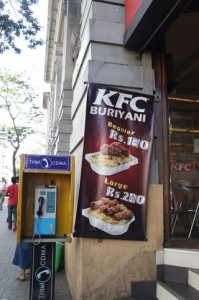 With arrack checked off my shopping list, we head to the Royal Botanic Gardens in Peradeniya, just a few miles outside Kandy. Upon entering, Sid and I realize that there is no way we’ll be able to cover all 147 acres of this massive garden. We aren’t sure which way to turn so we wander for a while down a path with tall pointy trees bending away from the pathway in formation. There are families out for the day, roving bands of British and German tourists and couples holding hands or sitting under trees. It’s a place I would love to visit for a day, strolling its paths and sitting with a good book. I definitely see the influences of British gardens from my travels in England. The garden was established here by the Brits in 1821. We’ve carved out 30 minutes here, so we decide to be more purposeful in our visit, turning to the map. We decide upon the flower garden and the orchid house. On our way, we spot a pathway of regal royal palms that we’d love to go down, but the flowers are in the other direction. We start to think you may need more than one visit to see everything here. The flower garden features little beds of red, white and purple blooms, but I love the pathway of red, green and orange leafy coleus plants the most. Another wedding party likes it too, posing for photos. Just beyond the flower garden is the orchid house where I learn there are 188 varieties of orchids native to Sri Lanka. The house has a good representation of these with orchids that look like they are dripping from their stems and orchids in purples, pinks and oranges. We leave the gardens leaving the spice garden, cacti and bamboo collection behind.
With arrack checked off my shopping list, we head to the Royal Botanic Gardens in Peradeniya, just a few miles outside Kandy. Upon entering, Sid and I realize that there is no way we’ll be able to cover all 147 acres of this massive garden. We aren’t sure which way to turn so we wander for a while down a path with tall pointy trees bending away from the pathway in formation. There are families out for the day, roving bands of British and German tourists and couples holding hands or sitting under trees. It’s a place I would love to visit for a day, strolling its paths and sitting with a good book. I definitely see the influences of British gardens from my travels in England. The garden was established here by the Brits in 1821. We’ve carved out 30 minutes here, so we decide to be more purposeful in our visit, turning to the map. We decide upon the flower garden and the orchid house. On our way, we spot a pathway of regal royal palms that we’d love to go down, but the flowers are in the other direction. We start to think you may need more than one visit to see everything here. The flower garden features little beds of red, white and purple blooms, but I love the pathway of red, green and orange leafy coleus plants the most. Another wedding party likes it too, posing for photos. Just beyond the flower garden is the orchid house where I learn there are 188 varieties of orchids native to Sri Lanka. The house has a good representation of these with orchids that look like they are dripping from their stems and orchids in purples, pinks and oranges. We leave the gardens leaving the spice garden, cacti and bamboo collection behind.
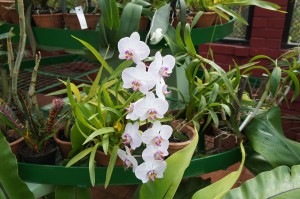 I still haven’t picked up any silk, so we stop at Gaja Fashions on our way out of Kandy and its environs as we head to our next destinations, Dambulla and Sigiriya. At Gaja, a young woman shares the process of making silk garments starting from silk worm to weaving loom. I’ve decided to get a few silk scarfs and there are too many to choose. There are scarves with designs, some tightly woven, others loosely woven. The variety of colors is staggering. I’ve finally made my selections and I think I’m ready to purchase, when the young sales girl goes in for the kill. She asks if I’d like to try on a sari. Of course, I do. She takes me to a wall to pick out a fabric. The first I select, she says is too bulky. Finally, I pick one that is shades of orange, one of my favorite colors, with gold accents. She finds a matching half top. In the top and my shorts, she begins wrapping the fabric low around my hips and asks if I’d like a Sri Lankan style sari or an Indian style. I opt for Sri Lankan. She puts a stretchy fabric band around my waist, not unlike a rubber band and begins pulling the edges of the fabric up and through to make a small frill. She has already intricately folded the top part of the sari into pleats to hang over my shoulder. When she’s done, I feel transformed. Sid and Pradeep look at me with eyes wide and say, “You look so pretty! You look like a Sri Lankan!” The ladies in the shop seem impressed, too. We take pictures and the sales girl asks if I want to buy the sari. I contemplate it, but then the practical takes over. Where in the world am I going to wear a sari in DC? I missed my shot at wearing one while crashing a White House state dinner and someone has already done it, so I leave the sari behind.
I still haven’t picked up any silk, so we stop at Gaja Fashions on our way out of Kandy and its environs as we head to our next destinations, Dambulla and Sigiriya. At Gaja, a young woman shares the process of making silk garments starting from silk worm to weaving loom. I’ve decided to get a few silk scarfs and there are too many to choose. There are scarves with designs, some tightly woven, others loosely woven. The variety of colors is staggering. I’ve finally made my selections and I think I’m ready to purchase, when the young sales girl goes in for the kill. She asks if I’d like to try on a sari. Of course, I do. She takes me to a wall to pick out a fabric. The first I select, she says is too bulky. Finally, I pick one that is shades of orange, one of my favorite colors, with gold accents. She finds a matching half top. In the top and my shorts, she begins wrapping the fabric low around my hips and asks if I’d like a Sri Lankan style sari or an Indian style. I opt for Sri Lankan. She puts a stretchy fabric band around my waist, not unlike a rubber band and begins pulling the edges of the fabric up and through to make a small frill. She has already intricately folded the top part of the sari into pleats to hang over my shoulder. When she’s done, I feel transformed. Sid and Pradeep look at me with eyes wide and say, “You look so pretty! You look like a Sri Lankan!” The ladies in the shop seem impressed, too. We take pictures and the sales girl asks if I want to buy the sari. I contemplate it, but then the practical takes over. Where in the world am I going to wear a sari in DC? I missed my shot at wearing one while crashing a White House state dinner and someone has already done it, so I leave the sari behind.
We are back on the A2 again heading farther north towards the ancient cities of Dambulla and Sigirya. We’ve got some snacks of roti for the road and Pradeep asks if I’ve had lychee before as he stops at a roadside stand. I haven’t, so we buy several red spiky orbs for me to taste. Sid demonstrates how to eat one by biting halfway through the prickly rind and popping the skin back to reveal a white fleshy center. He says there’s a pit inside the fruit that you don’t eat. As I take a bite, I am reminded of kiwi. It has the same texture, but may be a little sweeter. It’s delicious. Soon we are passing through the Knuckles mountain range, a UNESCO World Heritage Site named for its shape. Sri Lanka has at least 8 World Heritage sites and I’ll see four of them on this road trip. I’ve already seen Galle Fort, the Knuckle Mountains and we are on our way to the other two.
We pass up Dambulla to head straight to Sigiriya, about 30 minutes away, to go to our hotel and rest a bit. We’ve decided to visit the Rock Cave Temple at Dambulla this evening and climb the ancient rock at Sigirya in the morning before making the trip back to the coast and finally, the airport. The path to the Lion Rock Hotel reminds me of the ride through Yala National Park. It’s a bumpy ride down a dirt road. But when we arrive, the hotel is in the middle of a little green oasis, featuring cute gingerbread house bungalows. The owner of the place offers rooms off the balcony with a view of the massive rock we are to climb the next day. We are also given freshly squeezed lemonade with a bit of sugar. I enjoy our break, sipping the tangy refreshment and listening to a pair of birds chat in the trees over my head.
About an hour later, we are back in Dambulla and we’ve arrived at the Royal Rock and Golden Temples just before closing, which is probably good because this is one of the must-see destinations in Sri Lanka. It is understandable because there is a gargantuan golden Buddha, measuring 100-feet tall, staring down at us from the top of the Golden Temple. It’s hard to take your eyes off it. The Golden Temple houses the monastery for the monks who care for the Rock Temple, a collection of caves containing stone Buddha statues. We make our way up a series of steps carved into a sloping rock face. Halfway up, I look back to see the back of the golden Buddha and Dambulla below. We aren’t alone here. There are some tourists, vendors and guides who want to help lead you up to the caves. There is also a troop of monkeys grooming one another and oblivious to the camera-toting tourists around them. Sid says the monkeys can get aggressive, taking food and anything else that catches their fancy from passerby. We come to a small landing in the rock and a white hut marking the entry way to the temple. Sid and I leave our shoes outside the temple with Pradeep, who’s seen this place many times. There are white-columned facades at the entrances to each cave, tucked under the rock’s natural overhang. The temples are said to date back to the 1st century BC. An ancient king driven from his kingdom took refuge in the caves here and when restored to the throne had the Buddha statutes carved into the caves as a place of worship. When we enter the first cave, I am met with the face of a long Buddha in repose. It is dim inside, but I see the Buddha is not alone. There is a seated Buddha and a standing figure in the cave, too, with frescoes of other prayerful figures. I get a sense of the size of this Buddha simply by looking at its floral painted feet almost as tall as I. I’d later learn that this Buddha is 47 feet in length. Starring at the feet, I am suddenly approached by a man in all white asking where I’m from. I tell him that I am from the US and he smiles. He says, “Your president is black like you and me.” I say, “Yes.” He says he likes him very much and starts to tell me more about the cave and the temple. We realize that he’s a freelance tour guide hoping to score a tourist and I thank him, before moving on to the next cave. There are five in total, holding a whopping 150 Buddhas and paintings of other gods and goddesses. It is a visual feast for the eyes. The second cave is the largest with Buddha seated, standing and laying in a variety of poses, and frescos in reds, creams and yellows covering almost every inch of the walls. I am most impressed with the Buddha shielded by the hood of a King Cobra, and in another cave, the the serene, full-lipped yellow face of another Buddha in repose. I want to go home and read Siddhartha from my middle-school religion class again after all this Buddha gazing. I couldn’t snap enough pictures in this place. The dimness of the light, the amount of detail in each sculpture and painting and just the sheer wonder of how all this was accomplished in such an obscure and amazing setting made this a great stop and well worth the climb. The sun makes its decline as we make ours from the rock and head back to Sigirya. I can’t believe that I just have one more day.
